Top News
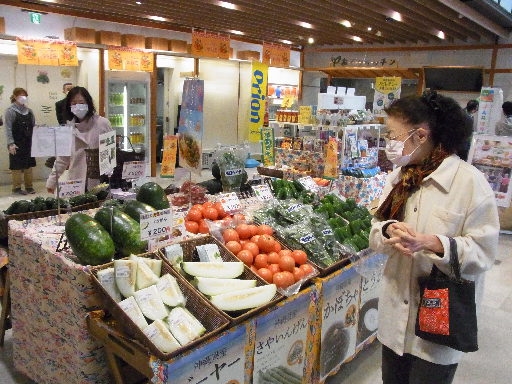
February 3, 2021 Ryukyu Shimpo
Tokyo – On February 2, the Haisai! Okinawa Festival began at JA Tokyo AgriPark in Yoyogi, Tokyo. The event is run by JA Okinawa and showcases Okinawan tourism and products. The festival will share Okinawan tourism, goods, and produce like bitter melon (goya) with the Greater Tokyo Area through February 6.
Many items were sent from Okinawa for the festival, from kogiku flowers and seven vegetables, including green beans and kabocha squash, to Okinawan soba and island tofu (shima dofu). Shoppers could be seen excitedly choosing items. Each day, a limited number of the day’s special bento are sold. This could be taco rice (takoraisu), bitter melon, braised pork belly bowls (rafute don), or something else.
Hideko Takeishi of Tokyo says, “With the coronavirus, we can’t go to Okinawa, so these opportunities are precious. This is my first time buying an Okinawan kabocha squash. If it’s good, I hope to buy it again.”
This is the fourth time the event has been held. Coronavirus measures have been implemented this year. This year’s festival is on a smaller scale, with no free samples or cooking classes, and no on-site dining.
(English translation by T&CT and Ellen Huntley)
Go to Japanese

February 3, 2021 Ryukyu Shimpo
According to a visual inspection conducted by the Okinawa Defense Bureau starting in April 2017, the number of takeoffs/landings performed by aircraft at U.S. Marine Corps Air Station (MCAS) Futenma for the year of 2020 was 17,500, the highest number since the inspection began. The number of takeoffs/landings by aircraft stationed at MCAS Futenma reached the highest number ever at 14,850, boosting the total. Aircraft from elsewhere accounted for 2,650 takeoffs/landings.
The total number in 2020 is a 0.6 percent increase from the 2019 total of 17,397 takeoffs/landings, but a 14.6 percent increase from the 2018 total of 15,270. The takeoffs/landings by the aircraft stationed at MCAS Futenma in 2020 is a 2.4 percent increase from the 14,495 takeoffs/landings in 2019, and a 5.3 percent increase from the 14,104 in 2018.
In 2020, the takeoffs/landings by aircraft from elsewhere decreased 8.7 percent from 2902 in 2019, yet increased by 2.3 times from 1166 in 2018. In 2019, one of Kadena Air Base’s two runways was closed for construction, and the number of aircraft from elsewhere flying into MCAS Futenma appeared to increase, but then in 2020, as well, aircraft from elsewhere continued to fly in.
Night flights after 10:00 p.m., restricted by the aircraft noise regulation measures (noise prevention agreement), occurred 334 times in 2020, which is a decrease from 340 in 2019, and a decrease from 705 in 2018.
There were 2,158 takeoffs/landings at MCAS Futenma in December 2020, approximately double the 1066 in November 2020. The takeoffs/landings by aircraft stationed at MCAS Futenma numbered 1891 in December 2020, approximately 2.4 times the 778 in November 2020. The takeoffs/landings by aircraft from elsewhere numbered 267 in December 2020, a 7.3 percent decrease from the 288 in November 2020. Aircraft from elsewhere that performed takeoffs/landings at MCAS Futenma included MV-22 vertical takeoff and landing transport aircraft.
(English translation by T&CT and Erin Jones)
Go to Japanese
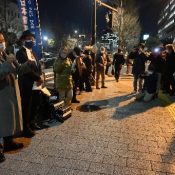
February 4, 2021 Ryukyu Shimpo
Tokyo—On the evening of February 3, citizens opposed to the relocation of U.S. Air Station Futenma to Henoko, Nago City, protested in front of the Japanese Prime Minister’s official residence in Tokyo. The protest was precipitated by the Fukuoka High Court Naha branch’s ruling, in which the court sided with the central government and rejected the Okinawan government’s suit to block the transplantation of coral species from Oura Bay. According to organizers, about 100 citizens rushed to protest the quashing of local governance and dignity.
Yoichi Iha and Tetsumi Takara, members of the House of Councillors elected from Okinawa (Okinawa Whirlwind, or Okinawa no Kaze), joined the protest and criticized the court’s decision, and called for nation-wide solidarity to halt the base construction.
(English translation by T&CT and Monica Shingaki)
Go to Japanese
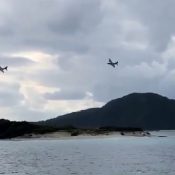
February 4, 2021 Ryukyu Shimpo
After U.S. military aircraft were spotted flying at low altitude near the Kerama islands, Okinawa gubernatorial chief of staff Masaru Kinjo lodged a protest to 353d Special Operations Group Commander Colonel Michael A. Thomas on February 3. According to Okinawa, the military stressed the legality of the flights, claiming “we confirmed that we were adhering to the standards related to flight agreed between the United States and Japan, and that we were well within the limits for flight over Japanese airspace.” Kinjo indicated however,” [The aircraft] were clearly below the altitude specific in Japanese law,” asking that they reinvestigate.
Kinjo also claimed, “It is extremely regrettable that are residents were caused anxiety,” and demanded that 1) training not be conducted outside of the provided facilities and designated areas, 2) that the U.S. military adhere to the minimum flight altitude restriction according to the International Civil Aviation Organization (ICAO) and under Japanese law, as agreed to by the Japan-U.S. Joint Committee, and to not conduct low-altitude flights that would cause Okinawans anxiety, and 3) provide detailed information about the altitude of the current flight in question.
According to Okinawa Prefecture, Col. Thomas said that regarding the protest and demands, “I would like to notify U.S. Forces Japan command.”
Due to the coronavirus restrictions, a face-to-face meeting was not possible, so the protest was made over the phone. A letter of protest was also mailed.
(English translation by T&CT and Sam Grieb)
Go to Japanese
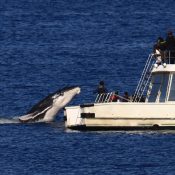
February 2, 2021 Ryukyu Shimpo
Takeshi Asato, 45, was at home in Miyagi, Chatan, on January 31 when he photographed a humpback whale jumping majestically out in the ocean.
That day, Asato noticed a tourist boat docked close to shore and watched on with curiosity. When a humpback whale leaped out of the water with great force, Asato frantically captured the scene on his camera.
The tourist boat is owned and operated by JAM Marine Club, a diving shop in Kadena. Observers onboard said the whale was swimming in such shallow waters that it was visible from land before leaving the harbor. “It’s rare to see such powerful jumps at close range,” said a staff member.
Humpback whales are known to feed in waters around Russia’s Kamchatka Peninsula in the summer and migrate during the winter to breed and raise their young in Amami, Okinawa, the Ogasawara Islands, and the Philippines.
(English translation by T&CT and Monica Shingaki)
Go to Japanese
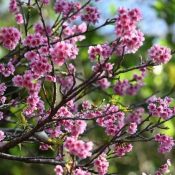
February 2, 2021 Ryukyu Shimpo
The Okinawa Regional Headquarters of the Japanese Meteorological Association (JMA) announced February 1 that the cherry (hikanzakura) blossom trees in Naha were in full bloom. The announcement comes three days earlier than the yearly average, and two days earlier than the previous year.
In Naha’s Sueyoshi Park (Shurisueyoshi-cho), around 80% of the trees have blossomed. On February 1, the temperature in Naha was 23.5 degrees Celsius, and the February 2 continued the trend of warm weather, hitting 22.1 degrees by 10:00 a.m., warm enough for people to walk around without a jacket.
In Okinawa, cherry blossoms are mostly hikanzakura trees, characterized by their pink flowers that point downward. Someiyoshino cherry trees are almost non-existent in the region. A steady temperature needs to be maintained throughout the winter in order for the trees to bloom fully.
(English translation by T&CT and Sam Grieb)
Go to Japanese
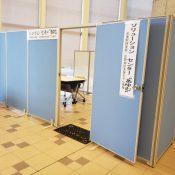
January 29, 2021 Ryukyu Shimpo
by Wakana Arakaki
Chatan – After a woman was killed by a U.S. soldier in the Kuwae neighborhood of Chatan, Okinawa in April of 2019, Okinawa Prefecture opened a counseling service called “Solution Center Ayumu) January 5 in Chatan Town Hall, for the benefit of women who are facing domestic issues or relationship problems with members of the U.S. military. It is the first public counseling service that specializes in issues with the U.S. military.
In the 2019 incident, a sailor from the U.S. Navy killed a Chatan woman who he at one point had a relationship with, after which he committed suicide. American and Japanese investigators were aware of issues in the relationship, but were unable to stop the murder. After the incident, there was public outcry for the establishment of a public point of contact where people could for counseling and to help resolve issues with U.S. military personnel.
The office is targeted towards people living in Okinawa who are experiencing issues with U.S. military personnel stationed in Okinawa. The office has a pair of support staff for issues such as: 1) marriage, divorce, and relationship issues, 2) acknowledgement of paternity 3) child support, and 4) domestic violence. It also offers services such as accompanying women to talk with military personnel, contacting military offices, and appearing in place of women who come for assistance.
The office’s budget for 2020 was 9 million yen, and the forecast for 2021 is 10 million yen. Okinawa Prefecture has entrusted the Okinawa Single Parents and Children’s Welfare Association (Okiboren) with managing the counseling office. However, since a matching counseling service has not been set up by the U.S. military, and there is a need for someone well versed in private law as well as knowledgeable about the situation inside the bases, the overall operations will be supported by Women’s Pride representative Misaki Smith, who has been counseling international households in Okinawa for many years.
The counseling office asks for making appointments in advance. They can be reached weekdays from 9:00 a.m. – 5:00 p.m. at 080 (7980) 4291.
(English translation by T&CT and Sam Grieb)
Go to Japanese

January 29, 2021 Ryukyu Shimpo
On January 28, the U.S. Marine Corps (USMC), stationed in Okinawa, and the Ground Self-Defense Force (GSDF) started joint training at the Kin Blue Beach Training Area against the wishes of the Okinawa prefectural government, which requested restraint for the sake of countering the spread of the novel coronavirus. In addition to approximately 2,500 USMC personnel, approximately 250 personnel from the GSDF Amphibious Rapid Deployment Brigade participated in the training. Concerned citizens gathered in front of Camp Hansen and demanded that the joint training stop.
The plan is for landing training starting on February 1 on Blue Beach, and for the entire joint training to be carried out until February 6. During the first day of training on January 28, a Landing Craft Air Cushion (LCAC) repeatedly landed on the shore of Blue Beach carrying High Mobility Artillery Rocket Systems (HIMARS), and military vehicles and personnel disembarked from the LCAC.
On January 28 the Amphibious Rapid Deployment Brigade rode, on Osumi vessels of the Maritime Self-Defense Force (MSDF), from its current placement in Sasebo City in Nagasaki Prefecture. Hereafter, the Brigade will be transferred to Okinawa, and there is talk of a proposal to permanently station the GSDF Amphibious Rapid Deployment Brigade at Camp Schwab. Following January 29, other divisions of the GSDF are also being transferred.
As the novel coronavirus continues to spread nationwide, a GSDF spokesperson explained that the GSDF is taking thorough countermeasures, such as minimizing contact with the general public and reducing cases in which divisions intermingle.
(English translation by T&CT and Erin Jones)
Go to Japanese

January 29, 2021 Ryukyu Shimpo
Miyako-jima – On January 28, the city of Miyako-jima confirmed 35 new cases of Covid-19 in one day, a record high. Recently, every day has set a new record for the highest number of new cases in a day. Residents’ worry is obvious. “At this point, it isn’t a spread of infections, it’s an explosion of infections,” one said. Another commented, “It’s as though the entire island has been blanketed with coronavirus.” Public buildings and parks have been closed. Schools are closed. Restaurants are closed, transforming the liveliest main streets on the island into shuttered streets.
At 8 p.m. on January 28, the main street of Nishizato, Hirara in Miyako-jima was silent. The street, which is lined with souvenir shops, bars, and restaurants, is normally lively with tourists and local customers. However, on this day, the street was deserted. Most businesses had lowered their shutters and hung signs saying “closed.”
In response to the city’s state of emergency announcement on January 26, a Miyako-jima association of restaurants and other businesses, of which 80 businesses in Miyako-jima are members, called for all member businesses to close. The head of the association, Genshin Okuhira, says that more than 90% of member businesses cooperated. He says, “Drinking calms the nerves, but we can’t supply alcohol right now. We have to withstand this situation. Until the coronavirus is under control, businesses and customers have no choice but to cooperate.”
There are no children at the schools. A woman who lives near an elementary school tweeted, “It was nice hearing the kids playing during recess. It feels the island is blanketed with coronavirus. It’s scary.” Some parents and guardians are raising concerns about having a place for their children to be. One woman with two children in elementary school says, “My husband and I both work. We tell the kids not to go out, but there’s a limit. I just want the outbreak to be under control soon.”
Municipal parks are blocked off with ropes. A man who came to the park for a walk saw the sign saying that the park was closed and turned back. He said, “The (Miyako-jima) hospital is working so hard to deal with the coronavirus that they’ve even suspended outpatient care. If we keep seeing tens of people like we have been, it’ll be the end of the island. At this point, it isn’t a spread of infections, it’s an explosion of infections.”
(English translation by T&CT and Ellen Huntley)
Go to Japanese
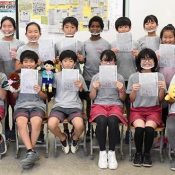
January 16, 2021 Ryukyu Shimpo
Uruma City—Throughout the 2020 school year, Okinawa AMICUS International Elementary School teacher Kaoru Joanna Uezu worked with her fifth-grade class to send submissions to the “Voice” and “Ryu PON!” sections of the Ryukyu Shimpo. The children’s submissions were accepted one by one, and on December 23, the last student’s work was printed—meaning all 21 students in the class have been published. Uezu’s class the previous year accomplished this feat as well.
One student had ten submissions printed since April, including the Okinawa Times. Another student, Aine Matsumura, 11, said, “My most memorable submission was about my appreciation for the support from my teachers and the people around me.” Uezu explained, “Every year for about 20 years, I’ve had my students make submissions to newspapers. It offers the children a great opportunity to express and communicate their thoughts through various channels.”
(English translation by T&CT and Monica Shingaki)
Go to Japanese
January 25, 2021 Ryukyu Shimpo
A secret 2015 agreement reached between the Japan Ground Self-Defense Force (JGSDF) and the U.S. Marine Corps has come to light. The deal agrees to station the JGSDF’s remote island defense unit, the Amphibious Rapid Deployment Brigade (ARDB), at U.S. Camp Schwab in Henoko, Nago City. The matter was not decided on by the entire Ministry of Defense and is a significant issue that violates civilian control, a major principle underlying democracies in which politics prevail over military affairs.
The JGSDF and the U.S. Marine Corps’ top leaders in Okinawa had come to an agreement, coordinated, and presented a joint JGSDF-facility proposal to the parties concerned.
The deployment of the ARDB, also known as the Japanese Marines, is an obvious reinforcement of the base’s capabilities and will lead to the base’s permanent status. The move may also increase tensions with China and further its targeting of the Okinawan islands.
Such critical security decisions that impose heavy burdens on residents should not be made without informing the sovereign people and their representatives, the Diet. A secret military agreement is undoubtedly an outrageous act that deviates from civilian control and destroys the very foundations of a nation that made its fresh start as a pacifist country.
About 9,000 U.S. Marines in Okinawa are expected to be relocated to Guam and other places abroad this decade. Relocating the Marines is professed to be a policy measure to reduce the military burden for Okinawa; if the ARDB is to replace the Marines, the move would be pointless.
The ARDB was deployed to Nagasaki Prefecture in 2018. There are currently two regiments in Nagasaki, but the idea is to place a third in Kyushu in fiscal 2023 and move one of the regiments to Henoko in the future.
The de facto blending of the U.S. military and the Self-Defense Forces provides us with context. In January and February of last year, the ARDB participated for the first time in the Japan-U.S. joint exercises held at the U.S. Blue Beach Training Area in Kin and other areas around Okinawa. Another joint exercise is scheduled for later this month at Blue Beach. ARDB’s participation could be in preparation for its deployment to Okinawa.
What is more, the joint use of U.S. military facilities in Japan technically reduces the number of U.S. forces’ exclusive-use facilities of which about 70% are concentrated in Okinawa. The intention may be to lessen the military burden for Okinawa, but only on paper–a deceptive maneuver.
In any case, the Self-Defense Forces’ reinforced presence in the Nansei Islands poses its own burden on Okinawa. As of 2018, the total area occupied by JSDF in Okinawa was 4.3 times more than that of the year Okinawa was returned to Japan. This number will increase further if the JSDF deploys to other areas, including the Sakishima Islands.
The Japanese government’s declaration to reduce Okinawa’s military burden is nothing more than a pipe dream. Despite the fact that 70% of voters opposed the land reclamation work at Henoko in a prefectural referendum, and although starting construction work on the soft seabed at Oura Bay seems improbable, the government is forcibly advancing the construction of a new military base at Camp Schwab.
The new Henoko base is expected to become a JGSDF base in the future, according to a JGSDF official. It is unacceptable that Okinawa should pay the price, as it did during WWII, because of an agreement that deviates from civilian control. We must not forget that the tragic Battle of Okinawa resulted from the Showa era history of allowing the military to run amok. Seventy-six years later, we refuse to shoulder the excessive military base burden and have our lives placed in constant danger.
(English translation by T&CT and Monica Shingaki)
Go to Japanese










 Webcam(Kokusai Street)
Webcam(Kokusai Street)


